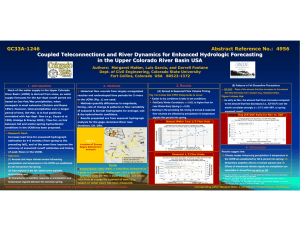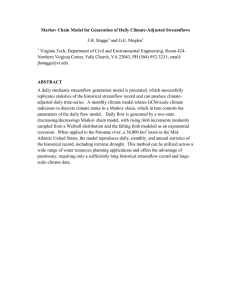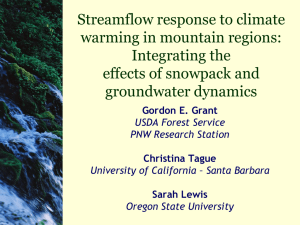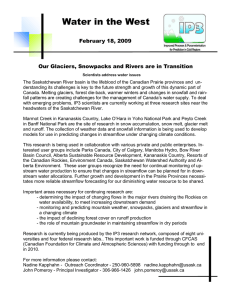Integrating geology, vegetation and snow regimes in climate change assessment for
advertisement
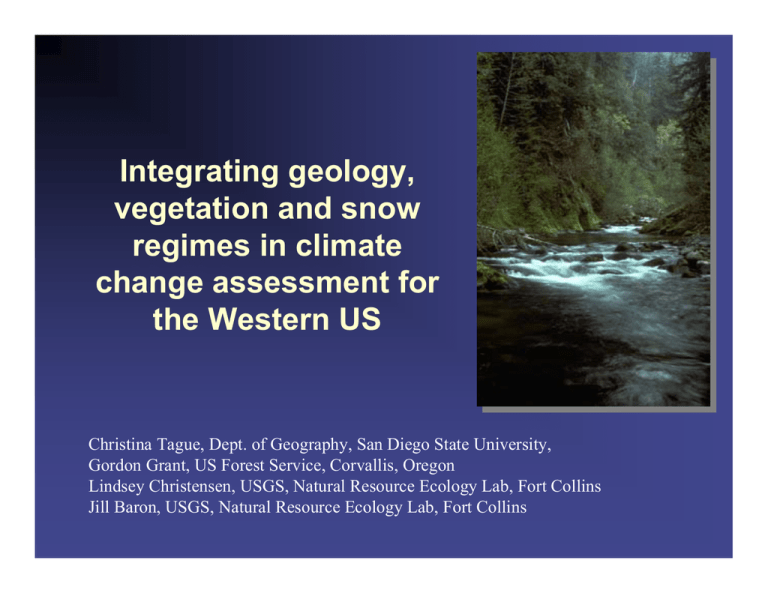
Integrating geology, vegetation and snow regimes in climate change assessment for the Western US Christina Tague, Dept. of Geography, San Diego State University, Gordon Grant, US Forest Service, Corvallis, Oregon Lindsey Christensen, USGS, Natural Resource Ecology Lab, Fort Collins Jill Baron, USGS, Natural Resource Ecology Lab, Fort Collins How sensitive is summer water availability (as streamflow and soil moisture for terrestrial ecological processes) to climate variability (in the mountains of the Western US)? How does this sensitivity vary in space? And across ‘relevant’ spatial scales? Mean Monthly Precipitation North Cascade Region (1895-1999) 20 10 Ju n Ju l Au g Se p O ct N ov D ec 0 Ja n Fe b M ar Ap r M ay cm 30 RECHARGE: Spatial Structure of Snow Accumulation Snowpack storage and subsequent melt is the primary source of recharge. Earlier snowmelt means water leaves the system earlier in the season and late summer streamflow is reduced. Spatial structure of “Snow-at-risk” defined by elevation and latitude mid-elevation Sierras and Cascades(Knowles and Cayan, 2004; Service et al. 2004; Mote et al., 2005, Nolin et al. in press, Hayhoe 2004; Payne et al. 2004) Remaining questions - what are the characteristic ‘resolution’ over which gradients in snow accumulation and melt must be defined to capture significant differences in summer streamflow? Climate-hydrology interactions in Western US mountains Processes and Drivers High Cascades Western Cascades Will am ette R iver Cl ac ka m N. Santiam as Drainage Efficiency: Geology Drained by large east-west trending tributaries (McKenzie and others) Elevation range 132 -3150 meters (transition from rain to snow-dominance) S.Santiam McKenzie Tributaries cross two distinct geologic regions High Cascades Western Cascades High and Western Cascade streams: Distinctive Summer Low Flow Regimes High Cascade stream shows muted peaks but greater summer baseflow with similar input precipitation High Cascades Western Cascades High Cascades Recent volcanic activity (Pleistocene to present) Gently sloping (shield volcano) dominated topography High vertical conductivity, poorly developed soils, Low density, disorganized drainage networks, combination of rapid shallow subsurface and deep groundwater drainage High Cascades Western Cascades Western Cascades High Miocene volcanic basalts and andesites Steep, highly dissected erosional topography vertical conductivity grading to shallow subsurface clay, saprolite confining layers High density, well developed shallow subsurface drainage network Empirical Analysis of USGS gage records for High/Western Cascade streams Log Mean August Streamflow (mm/month) 5.0 Mean August Streamflow 4.5 4.0 3.5 Summer streamflow recession characteristics 3.0 2.5 2.0 0% 20% 40% 60% 80% High Cascades in Contributing Area 6 Average August Discharge, 2002 100% Similar for stream temperature 5 mm/day 4 3 Western Cascade Stream s High Cascade Stream s 2 1 0 1 Predicted by percent High Cascade geology in the contributing area Tague, C.L, and Grant, G. (2004) “A geological framework for interpreting the low flow regimes of Cascade streams, Willamette River Basin, Oregon”, Water Resources Resarch, 40, W04303, doi:10.1029/2003WR002629, Tague et al (in press) , Hydrogeologic controls on summer stream temperatures in the McKenzie River basin, OregonHydrologic Processes. Implications of geologic-based classification and its correlation with summer streamflow volumes and temperatures Are differences in streamflow volumes due to geologic controls on flow or differences in elevation (more snow vs rain in the High Cascades)? Will these systems respond differently to climate warming? MODEL ANALYSIS of a High and Western Cascade watersheds Utilize RHESSys: spatially distributed physically based model of coupled eco-hydrologic systems http://geography.sdsu.edu/Research/Projects/RHESSYS/index.html Tague and Band (2004) Earth Interactions Modeling Case Study: Contrasting Watersheds Snow Precipitation MRCL: McKenzie River at Clear Lake, High Cascade (293km2) MRCLGW MRCL-SSF LOC: Lookout Creek, Western Cascades (64km2) LOC Rain Slow (Deeper Groundwater) Drainage Fast (Shallow Subsurface) 100 Log og discharge (mm/day) Western Cascade (LOC) Modeled Observed 10 1 st gu Au ay M ch M ar ry nu a r Ja m ve No pt em be be r ne Ju ri l Ap High Cascade (MRCLGW, MRCL-SSF) 10 1 Observed Modeled 0.1 ar y Ap ril Ju ne Au gu st O ct o De be r ce m be r Ja nu ar y Ap ril Ju ne Au gu st nu Ja ve m be r Modeled w/o gw No Log of discharge (mm/day) 100 Se De Fe ce br m ua be r ry 0.1 Model allows us to consider a hypothetical watershed: High Cascade (topography, vegetation, climate, snow accumulation and melt) but Western Cascade geology RHESSys streamflow estimates capture summer streamflow distinctions between High and Western Cascades - and shows that these are due primarily to geologic controls on drainage efficiency!! Relative (percent) change in modelled streamflow with a 1.5C warming scenario Greatest reductions occur for Western Cascade system, similar patterns obtained for a 2.5C warming Reduction in modeled August Flow (as unit discharge) with a 1.5C warming scenario Greatest losses are now associated with High Cascade system Relationship between modeled snowpack (water year max 15-day average) and observed August streamflow High Cascade watershed shows greater increase in summer flow with greater modeled snow Slope - High Cascade (0.003) vs Western Cascade (0.0004) Both statistically significant Implications for climate change impacts on water availability High Cascade watersheds a) contribute a disproportionate amount of flow in larger river basins and b) flow volumes are likely to be more sensitive to climate warming Large river water supply impacts (power generation, recreation, water supply for irrigation) Western Cascade watersheds, however, show greater relative sensitivity of summer streamflow to climate warming (and are warmer!) Distributed headwater stream habitat impacts (aquatic habitat) Differences in drainage efficiency are as important as topographic differences in apriori snow accumulation and melt in controlling flow regimes Geologic framework in the Sierras - will it matter there? total water input to soil Southern Cascades Volcanics (Hat Creek) Deep Groundwater Dominated Sierra-volcanic (Duncan Canyon Creek) Faster Sierra-granitic (Merced River; Cole Creek ) Shallow Sub-surface Flow Dominated Climate-hydrology interactions in Western US mountains Processes and Drivers How are important are spatial differences in plant water use in understand spatial patterns of hydrologic response to climate warming: summer streamflow? Disturbance (Logging, Fire) Spatial differences in plant responses to warming Initial increases in summer streamflow following fire/logging Changes in the timing and magnitude of evapotranspiration Longer term decreases in summer streamflow with associated changes in biomass and species in regrowth While studies have shown how biomass response to climate vary with topography within the Western US, fewer studies have explored the spatial structure of ET response RHESSys application Model Patches RHESSys couples estimation of ET (Penman-Monteith) with soil moisture and atmospheric/energy drivers. 900 800 700 precipitation (mm) RHESSys used to estimate changes in summer streamflow with climate variability for mature and disturbed catchments April - September (spring/summer) precipitation (mm) for CS2Met 600 500 400 300 200 100 1958 1959 1960 1961 1962 1963 1964 1965 1966 1967 1968 1969 1970 1971 1972 1973 1974 1975 1976 1977 1978 1979 1980 1981 1982 1983 1984 1985 1986 1987 1988 1989 1990 1991 1992 1993 1994 1995 1996 1997 1998 1999 0 year W1 Precipitation (Climate Scenarios) Total precipitation (mm) W8 W8 3500 3000 2500 2000 1500 1000 500 0 winter W1 W1 W1 summer total Seasonal Period Dry Year Dry Spring Wet Year Choate, J. “Combined impacts of harvesting and climate variability on summer flow for snow and rain dominated catchments in the Pacific Northwest”, MSc Thesis, San Diego State University Wet Spring Paired catchment experiments show long term reductions in August flow (associated with changes in riparian zone species) - Model results show similar reductions that are potentially even greater under altered climate scenarios. Do patterns of evapotranspiration-climate relationships follow a similar spatial structure? Is this structure the same as that of snow which also follows topographic gradients? Topography: redistribution of soil moisture; timing of recharge (snowmelt), air-temperature/vpd, radiation (slope, aspect) Case Study: RHESSysbased eco-hydrologic modelling: Yosemite/Merced River Basin (see Christensen et a Poster) 600 550 550 -2 Annual Transpiration (mm m ) 600 500 450 400 350 300 500 450 400 350 300 250 0 500 1000 Snowdepth (mm) 250 1500 17 0.8 0.75 CV Annual Transpiration Annual Transpiration (mm m-2) Basin Scale Transpiration-Climate Relationships 0.7 0.65 0.6 0.55 0.5 0 300 600 900 1200 Peak Snowdepth (mm) 1500 18 19 20 GSmeanT (C) 21 22 Spatial variation in annual transpiration - by elevation Can spatial differences in biomass (LAI) account for these patterns - partial So examine correlations with annual temperature, precpitation, snow and other indices by elevation Hig h elev atio ns Change in Transpiration (warm year - cold year) High sensitivity to temperature Small sensitivity to climate indicators Mid dle elev a tion s Change in Transpiration (high - average precip year) c d elev atio Low -347 0 Sensitivity to water stress ns Change in Transpiration (low - average precip year) Sensitivity to Temperature +170 Small sensitivity to climate indicators Change in transpiration Framework for assessing spatial structure of summer streamflow and its sensitivity to climate change and variability Spatial patterns of current summer streamflow and response to climate variation and change Process influence on summer flow Landscape Controls Modelling Issues Drainage Efficiency Discrete Geologic Classes (High vs Western Cascade), more spatially heterogeneous geologically defined units in Sierras MODEL: hydrologic parameters assigned based on geo-classes Recharge Gradient of topographic (aspect, elevation) control on snow accumulation and melt, and precipitation MODEL: relevant scale at which spatial variation in snow accumulation and melt must be defined Evapotranspiration Topographic differences in vegetation water use MODEL: stochastic disturbance regimes (fire:where, how much, how frequently) bgc- responses to climate Disturbance Regimes BIomass and Species Distributions geology topography Conclusions for a work in progress: Geology matters Topography matters for vegetation water use response but with a spatial structure that is likely different from that of snow Next? Systematic analysis that considers the intersection of the different characteristic spatial scales of geo-ecosnow US Geological survey Measurement strategies that link with model-based hypothesis

